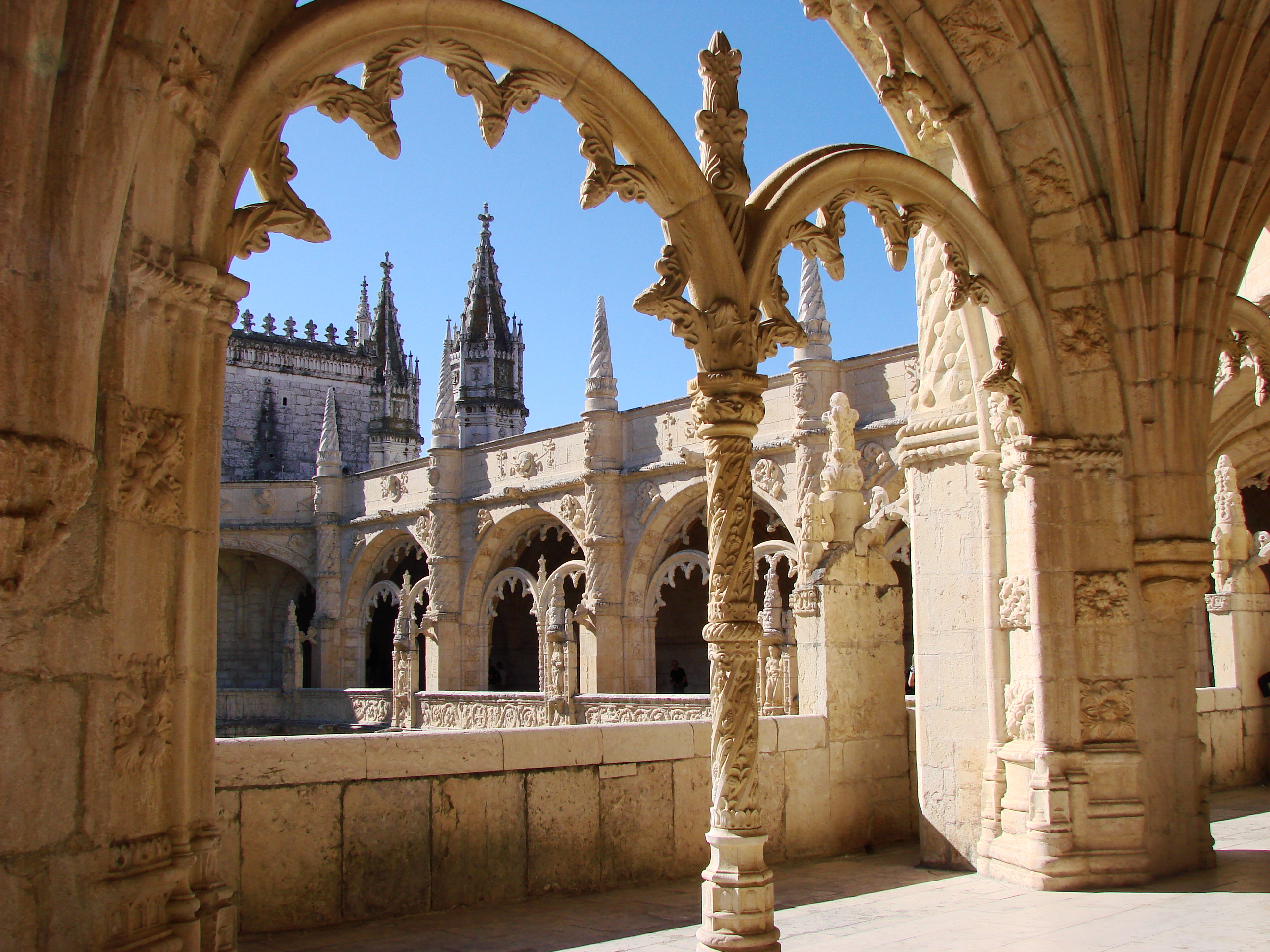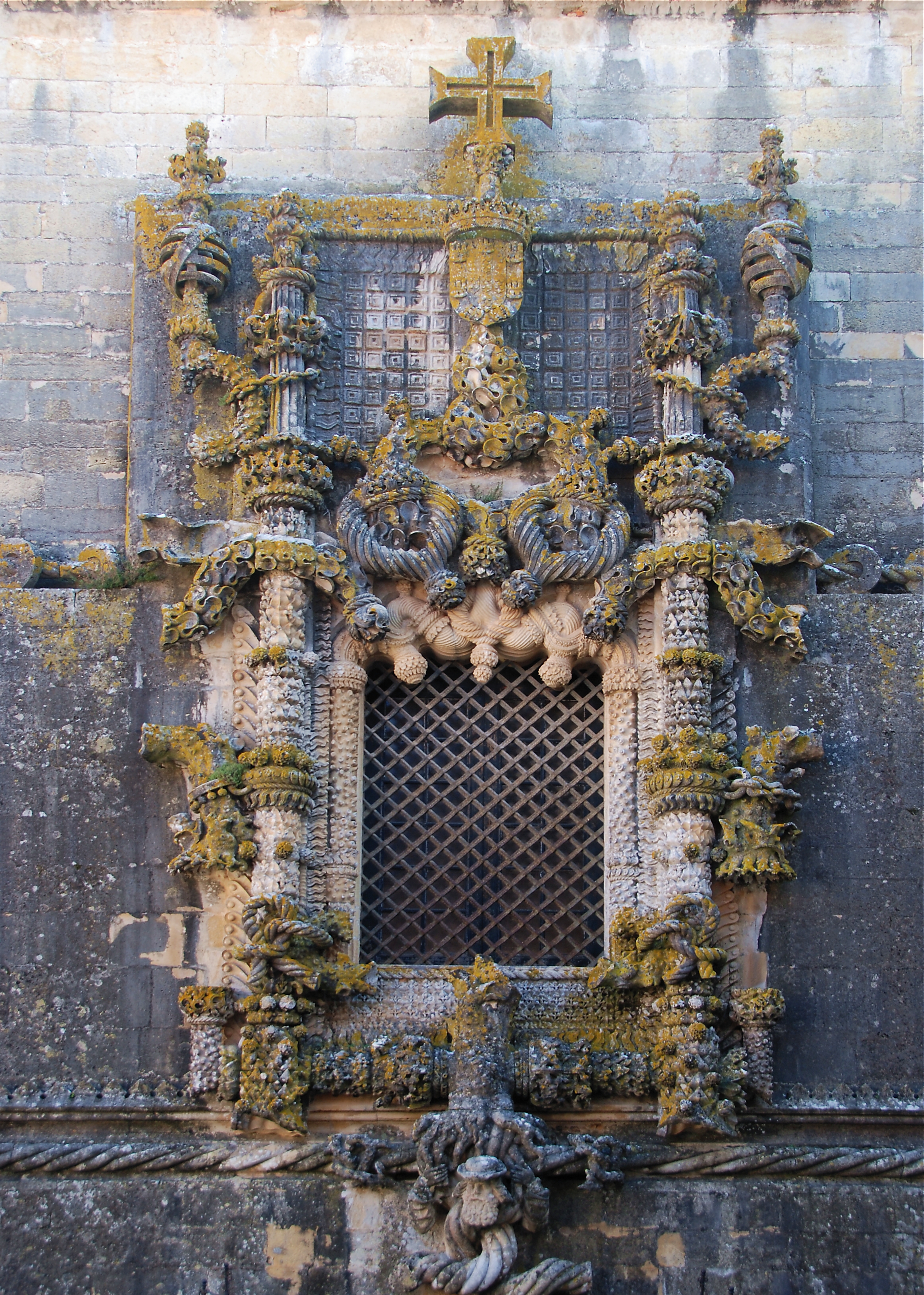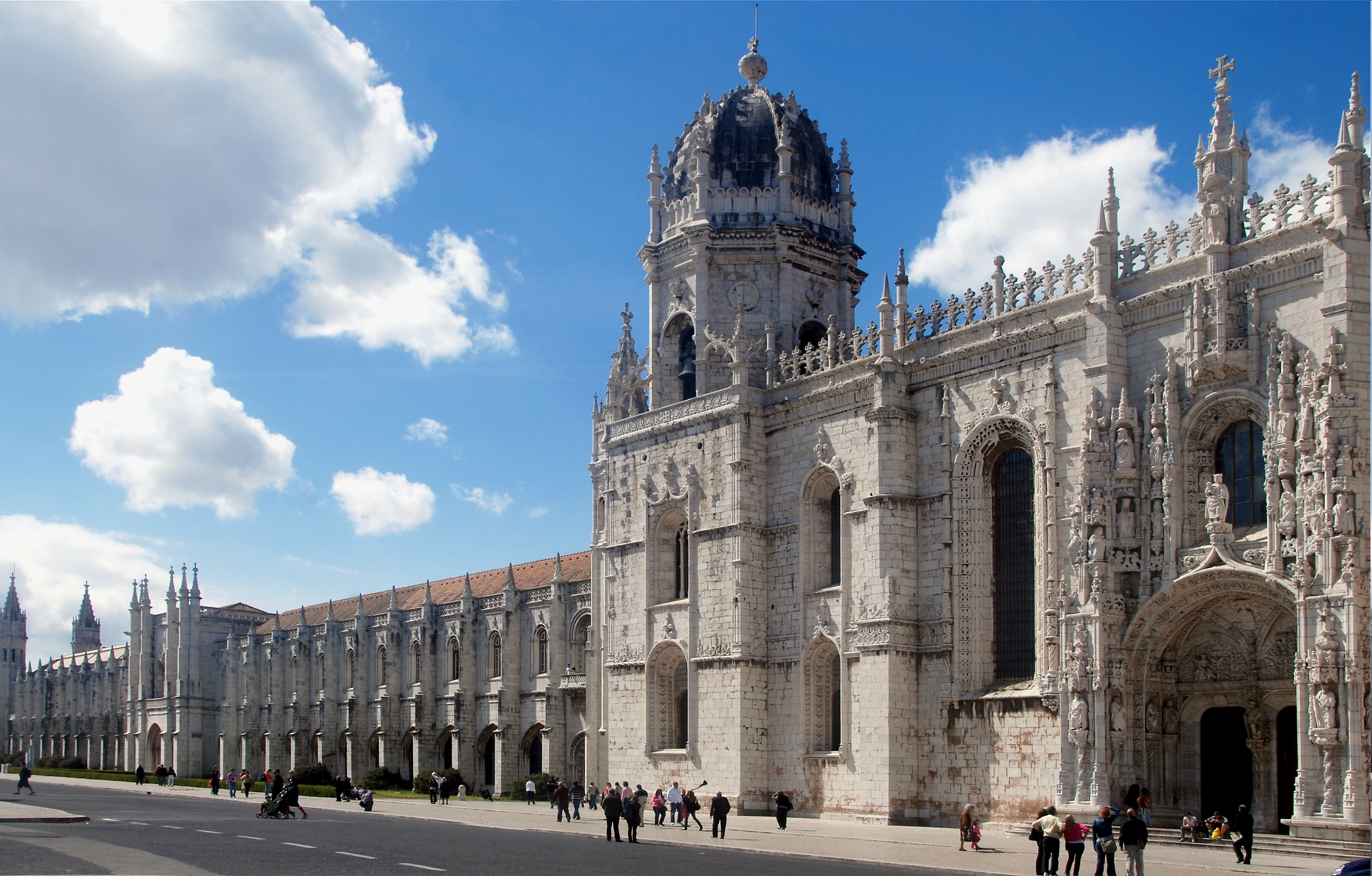Manueline on:
[Wikipedia]
[Google]
[Amazon]

 The Manueline ( pt, estilo manuelino, ), occasionally known as Portuguese late Gothic, is the sumptuous, composite Portuguese architectural style originating in the 16th century, during the
The Manueline ( pt, estilo manuelino, ), occasionally known as Portuguese late Gothic, is the sumptuous, composite Portuguese architectural style originating in the 16th century, during the
 This decorative style is characterized by virtuoso complex ornamentation in portals, windows, columns and arcades. In its end period, it tended to become excessively exuberant as in Tomar.
Several elements appear regularly in these intricately carved stoneworks:
* elements used on ships: the
This decorative style is characterized by virtuoso complex ornamentation in portals, windows, columns and arcades. In its end period, it tended to become excessively exuberant as in Tomar.
Several elements appear regularly in these intricately carved stoneworks:
* elements used on ships: the
 When King Manuel I died in 1521, he funded 62 construction projects. However, much original Manueline architecture in Portugal was lost or damaged beyond restoration in the
When King Manuel I died in 1521, he funded 62 construction projects. However, much original Manueline architecture in Portugal was lost or damaged beyond restoration in the  Outside Lisbon, the church and chapter house of the
Outside Lisbon, the church and chapter house of the

File:Capela de S Miguel Portal Manuelino Universidade de Coimbra IMG 0666.JPG, Doorway at the University of Coimbra
File:Elvas-Nª Sª Asunción 17.jpg, Doorframe in a church in Elvas
File:Igreja Matriz da Golega 96a.jpg, Doorframe of a church in Golegã
File:Evora, Palace (3921100752).jpg, Royal palace at Évora
File:Evora, Palace (3921098252).jpg, Royal palace at Évora, gallery.
File:Linhares - detalhe manuelino.jpg, Manueline furnishings of a 16th century Portuguese countryside house
File:Portal manuelino - Ayuntamientro de Olivenza.jpg, Manueline doorframe in Olivença, Spain.
File:Manueline Window at Pinhel.jpg, Manueline windowframe in Pinhel
File:Evora-ManuelineWindow.jpg, Windowframe in Évora
File:Bottega di lisbona, fonte bicefala con teste coronate e stemmi regali del portogallo, 1510-25 ca. 01.jpg, "Bicephalous Fountain", displaying both the heads of King Manuel and the Queen, and an armillary sphere, the royal emblem.
File:1 Exterior da igreja manuelina Convento de Cristo IMG 9479.jpg, Decorative motifs in the Monastery of Tomar
File:Goa-RosarioChurch.jpg, Manueline church in Goa, India.
File:Tracerías góticas (Claustro de D. João I, Monasterio de Batalha).jpg, Cloyster at the Batalha monastery
File:Mosteiro da Batalha 19a.jpg, Detail of decorative motifs in the Batalha Monastery
File:Mosteiro da Batalha 14a.jpg, Monastery of Batalha
File:Vista geral da capela.jpg, Chapel in Belém, Lisbon.
File:Capela de São Jerónimo 7601.jpg, Detail of the chapel in Belém.
File:Castelo de Alvito (Portugal)2.jpg, Castle of Alvito, with Manueline elements.
File:Solar da Sempre Noiva - Portugal (297263101).jpg, Sempre Noiva manor.
File:Paço dos Henriques de Transtâmara - Alcáçovas -Portugal (5623992584).jpg, Manor of the Henriques de Trastámaras, in Alvor.

Portuguese Renaissance
The Portuguese Renaissance refers to the cultural and artistic movement in Portugal during the 15th and 16th centuries. Though the movement coincided with the Spanish and Italian Renaissances, the Portuguese Renaissance was largely separate from ...
and Age of Discoveries
The Age of Discovery (or the Age of Exploration), also known as the early modern period, was a period largely overlapping with the Age of Sail, approximately from the 15th century to the 17th century in European history, during which seafarin ...
. Manueline architecture incorporates maritime elements and representations of the discoveries brought from the voyages of Vasco da Gama and Pedro Álvares Cabral
Pedro Álvares Cabral ( or ; born Pedro Álvares de Gouveia; c. 1467 or 1468 – c. 1520) was a Portuguese nobleman, military commander, navigator and explorer regarded as the European discoverer of Brazil. He was the first human i ...
. This innovative style synthesizes aspects of Late Gothic Flamboyant
Flamboyant (from ) is a form of late Gothic architecture that developed in Europe in the Late Middle Ages and Renaissance, from around 1375 to the mid-16th century. It is characterized by double curves forming flame-like shapes in the bar-tr ...
architecture with original motifs and influences of the Plateresque, Mudéjar, Italian
Italian(s) may refer to:
* Anything of, from, or related to the people of Italy over the centuries
** Italians, an ethnic group or simply a citizen of the Italian Republic or Italian Kingdom
** Italian language, a Romance language
*** Regional It ...
, and Flemish architecture. It marks the transition from Late Gothic to Renaissance. The construction of churches and monasteries in Manueline was largely financed by proceeds of the lucrative spice trade with Africa and India.
The style was given its name, many years later, by Francisco Adolfo de Varnhagen
Francisco Adolfo de Varnhagen, Viscount of Porto Seguro (February 17, 1816 – June 26, 1878), was a Brazilian diplomat and historian. He is the patron of the 39th chair of the Brazilian Academy of Letters. He is considered "the father of modern ...
, Viscount of Porto Seguro, in his 1842 book ''Noticia historica e descriptiva do Mosteiro de Belem, com um glossario de varios termos respectivos principalmente a architectura gothica'', in his description of the Jerónimos Monastery. Varnhagen named the style after King Manuel I, whose reign (1495–1521) coincided with its development. The style was much influenced by the astonishing successes of the voyages of discovery of Portuguese navigators, from the coastal areas of Africa to the discovery of Brazil and the ocean routes to the Far East.
Although the period of this style did not last long (from 1490 to 1520), it played an important part in the development of Portuguese art. The influence of the style outlived the king. Celebrating the newly maritime power, it manifested itself in architecture (churches, monasteries, palaces, castles) and extended into other arts such as sculpture, painting, works of art made of precious metals, faience and furniture.
Characteristics
 This decorative style is characterized by virtuoso complex ornamentation in portals, windows, columns and arcades. In its end period, it tended to become excessively exuberant as in Tomar.
Several elements appear regularly in these intricately carved stoneworks:
* elements used on ships: the
This decorative style is characterized by virtuoso complex ornamentation in portals, windows, columns and arcades. In its end period, it tended to become excessively exuberant as in Tomar.
Several elements appear regularly in these intricately carved stoneworks:
* elements used on ships: the armillary
An armillary sphere (variations are known as spherical astrolabe, armilla, or armil) is a model of objects in the sky (on the celestial sphere), consisting of a spherical framework of rings, centered on Earth or the Sun, that represent lines of ...
sphere (a navigational instrument and the personal emblem of Manuel I and also a symbol of the cosmos
The cosmos (, ) is another name for the Universe. Using the word ''cosmos'' implies viewing the universe as a complex and orderly system or entity.
The cosmos, and understandings of the reasons for its existence and significance, are studied i ...
), spheres, anchors, anchor chains, ropes and cables.
* elements from the sea, such as shells, pearls and strings of seaweed.
* botanical motifs such as laurel branches, oak leaves, acorns, poppy capsules, corncobs, and thistles.
* symbols of Christianity such as the cross of the Order of Christ (former Knights Templar), the military order that played a prominent role and helped finance the first voyages of discovery. The cross of this order decorated the sails of the Portuguese ships.
* elements from newly discovered lands (such as the tracery in the Royal Cloister of the Batalha Monastery
The Monastery of Batalha ( pt, Mosteiro da Batalha) is a Dominican convent in the municipality of Batalha, in the district of Leiria, in the Centro Region of Portugal. Originally, and officially, known as the ''Monastery of Saint Mary of the V ...
, suggesting Islamic filigree work, influenced by buildings in India)
* columns carved like twisted strands of rope
* semicircular arches (instead of Gothic pointed arches) of doors and windows, sometimes consisting of three or more convex curves
* multiple pillars
* eight-sided capitals
* lack of symmetry
* conical pinnacles
* bevelled crenellations
* ornate portals with niches or canopies.
Examples
 When King Manuel I died in 1521, he funded 62 construction projects. However, much original Manueline architecture in Portugal was lost or damaged beyond restoration in the
When King Manuel I died in 1521, he funded 62 construction projects. However, much original Manueline architecture in Portugal was lost or damaged beyond restoration in the 1755 Lisbon earthquake
The 1755 Lisbon earthquake, also known as the Great Lisbon earthquake, impacted Portugal, the Iberian Peninsula, and Northwest Africa on the morning of Saturday, 1 November, Feast of All Saints, at around 09:40 local time. In combination with ...
and subsequent tsunami. In Lisbon, the Ribeira Palace
Ribeira Palace (; pt, Paço da Ribeira) was the main residence of the Kings of Portugal, in Lisbon, for around 250 years. Its construction was ordered by King Manuel I of Portugal when he found the Royal Alcáçova of São Jorge unsuitable. The p ...
, the residence of King Manuel I, and the Hospital Real de Todos os Santos
The Hospital Real de Todos-os-Santos (''All Saints Royal Hospital'') was a major hospital in Lisbon, Portugal. The hospital was built between 1492 and 1504 and was destroyed in the 1755 Lisbon earthquake, along with most of the city. It was never f ...
were destroyed, along with several churches. The city, however, still has outstanding examples of the style in the Jerónimos Monastery (mainly designed by Diogo Boitac and João de Castilho) and in the small fortress of the Belém Tower
Belém Tower ( pt, Torre de Belém, links=no, ), officially the Tower of Saint Vincent ( pt, Torre de São Vicente, links=no) is a 16th-century fortification located in Lisbon that served as a point of embarkation and disembarkation for Portu ...
(designed by Francisco de Arruda). Both are located close to each other in the Belém neighbourhood. The portal of the Church of Nossa Senhora da Conceição Velha, in downtown Lisbon, has also survived destruction.
 Outside Lisbon, the church and chapter house of the
Outside Lisbon, the church and chapter house of the Convent of Christ
The Convent of Christ ( pt, Convento de Cristo/Mosteiro de Cristo) is a former Catholic convent in Tomar, Portugal. Originally a 12th-century Templar stronghold, when the order was dissolved in the 14th century the Portuguese branch was turned i ...
at Tomar (designed by Diogo de Arruda
Diogo de Arruda (before 1490 – 1531) was a noted Portuguese architect that was active during the early years of the 16th century. He had some other important family members including his brother, Francisco de Arruda and his uncle, Miguel ...
) is a major Manueline monument. In particular, the large window of the chapter house, with its fantastic sculptured organic and twisted rope forms, is one of the most extraordinary achievements of the Manueline style.
Other major Manueline monuments include the arcade screens of the Royal Cloister (designed by Diogo Boitac) and the Unfinished Chapels (designed by Mateus Fernandes) at the Monastery of Batalha
The Monastery of Batalha ( pt, Mosteiro da Batalha) is a Dominican convent in the municipality of Batalha, in the district of Leiria, in the Centro Region of Portugal. Originally, and officially, known as the ''Monastery of Saint Mary of the V ...
and the Royal Palace of Sintra.
Other remarkable Manueline buildings include the church of the Monastery of Jesus of Setúbal
The Monastery of Jesus ( pt, Mosteiro de Jesus) is a historical religious building in Setúbal, Portugal, which served a monastery of Poor Clare nuns. It is one of the first buildings in the Manueline style, the Portuguese version of late Gothic. ...
(one of the earliest Manueline churches, also designed by Diogo Boitac), the Santa Cruz Monastery
The Monastery of the Holy Cross ( pt, Mosteiro da Santa Cruz, links=no), also known as the Church of the Holy Cross, is a National Monument in Coimbra, Portugal. Because the first two kings of Portugal are buried in the church it was granted the s ...
in Coimbra
Coimbra (, also , , or ) is a city and a concelho, municipality in Portugal. The population of the municipality at the 2011 census was 143,397, in an area of .
The fourth-largest urban area in Portugal after Lisbon Metropolitan Area, Lisbon, Por ...
, the main churches in Golegã
Golegã () is a town and municipality in Santarém District, Portugal. The population of the municipality in 2011 was 5,913,including the parish Pombalinho, that changed from the municipality of Santarém to Golegã in 2013 in an area of 84.32&nbs ...
, Vila do Conde
Vila do Conde (, ; "the Count's Town") is a municipality in the Norte Region of Portugal. The population in 2011 was 79,533, in an area of 149.03 km². The urbanized area of Vila do Conde, which includes the parishes of Vila do Conde, Azurar ...
, Moura, Caminha
Caminha () is a municipality in the north-west of Portugal, 21 km north from Viana do Castelo, located in the Viana do Castelo District. The population in 2011 was 16,684, in an area of 136.52 km².
Caminha is subdivided into 14 civil pa ...
, Olivença and portions of the cathedrals of Braga
Braga ( , ; cel-x-proto, Bracara) is a city and a municipality, capital of the northwestern Portuguese district of Braga and of the historical and cultural Minho Province. Braga Municipality has a resident population of 193,333 inhabitants ( ...
(main chapel), Viseu
Viseu () is a city and municipality in the Centro Region of Portugal and the capital of the district of the same name, with a population of 100,000 inhabitants, and center of the Viseu Dão Lafões intermunipical community, with 267,633 inhabita ...
(rib vaulting of the nave) and Guarda (main portal, pillars, vaulting). Civil buildings in Manueline style exist in Évora (home to the Évora Royal Palace of 1525, by Pedro de Trillo, Diogo de Arruda and Francisco de Arruda) and the Castle of Évoramonte
The Castle of Evoramonte, alternately spelled ''Évora Monte'' or ''Évoramonte'', ( pt, Castelo de Évora Monte/Castelo de Evoramonte, links=no) is a Portuguese castle in the civil parish of Evoramonte, municipality of Estremoz in the former dist ...
of 1531), Viana do Castelo, Guimarães and some other towns.
The style was extended to the decorative arts and spread throughout the Portuguese Empire
The Portuguese Empire ( pt, Império Português), also known as the Portuguese Overseas (''Ultramar Português'') or the Portuguese Colonial Empire (''Império Colonial Português''), was composed of the overseas colonies, factories, and the ...
, to the islands of the Azores
)
, motto =( en, "Rather die free than subjected in peace")
, anthem= ( en, "Anthem of the Azores")
, image_map=Locator_map_of_Azores_in_EU.svg
, map_alt=Location of the Azores within the European Union
, map_caption=Location of the Azores wi ...
, Madeira, enclaves in North Africa, Brazil, Goa in Portuguese India and even Macau, China. Its influence is apparent in southern Spain, the Canary Islands, North Africa and the former Spanish colonies of Peru and Mexico.
Famous Manueline artists
Architects
* Diogo Boitac * Mateus Fernandes *Diogo de Arruda
Diogo de Arruda (before 1490 – 1531) was a noted Portuguese architect that was active during the early years of the 16th century. He had some other important family members including his brother, Francisco de Arruda and his uncle, Miguel ...
* Francisco de Arruda
* João de Castilho
Painters
* Vasco Fernandes * Jorge Afonso *Cristóvão de Figueiredo
Cristóvão de Figueiredo (died ) was a Portuguese Renaissance painter.
Like many other important painters of the time, Cristóvão de Figueiredo was a pupil of Master Jorge Afonso, in Lisbon, in the early 16th century. He later worked together w ...
* Garcia Fernandes
* Gregório Lopes
Gallery

See also
*Neo-Manueline
Neo-Manueline is a revival style of architecture which drew from the 16th century Manueline Late Gothic architecture of Portugal. Neo-Manueline constructions have been built across Portugal, Brazil, and the Lusophone world (the former Portuguese ...
*Portuguese Architecture
Portuguese architecture refers to both the architecture of Portugal's modern-day territory in Continental Portugal, the Azores and Madeira, as well as the architectural heritage/patrimony of Portuguese architects and styles throughout the world, p ...
References
*Atanázio, ''A Arte do Manuelino'', Lisbon, Presença, 1984. *Turner, J., '' Grove Dictionary of Art'', Macmillan Publishers Ltd., 1996; *''The Rough Guide to Portugal'', March 2005, 11th edition, *Smith, Robert C.,'' The Art of Portugal 1500-1800''; Weidenfeld & Nicolson, London, 1968 {{Gothic architecture * Architectural styles Architectural history Maritime history of Portugal Architecture in Portugal